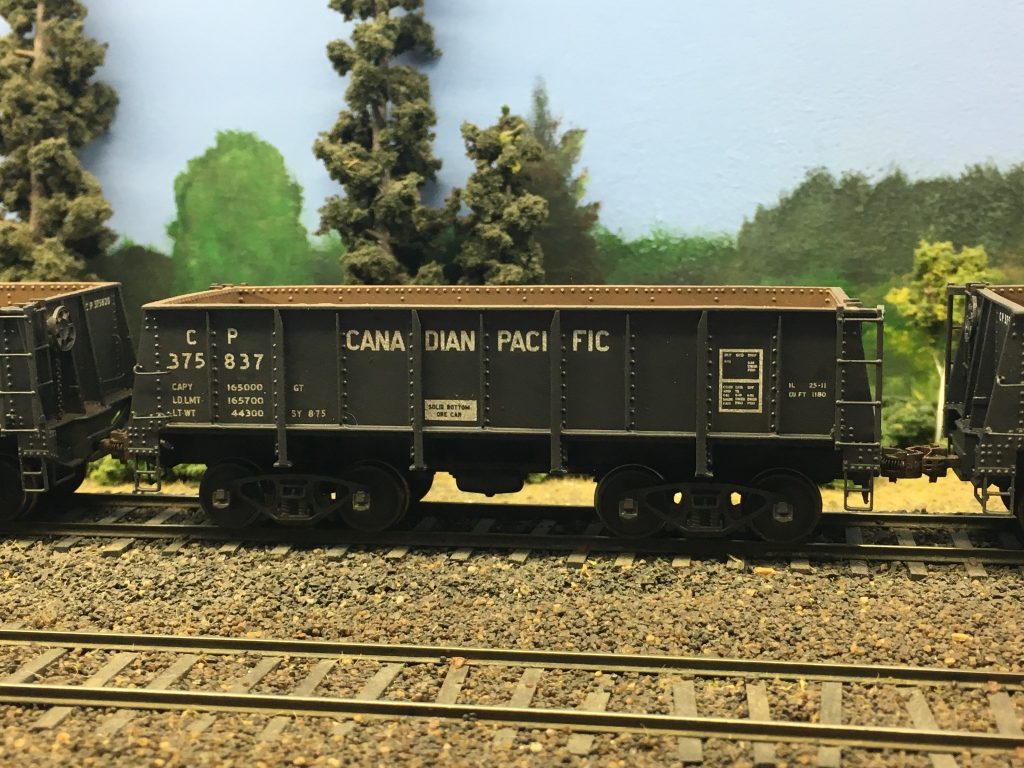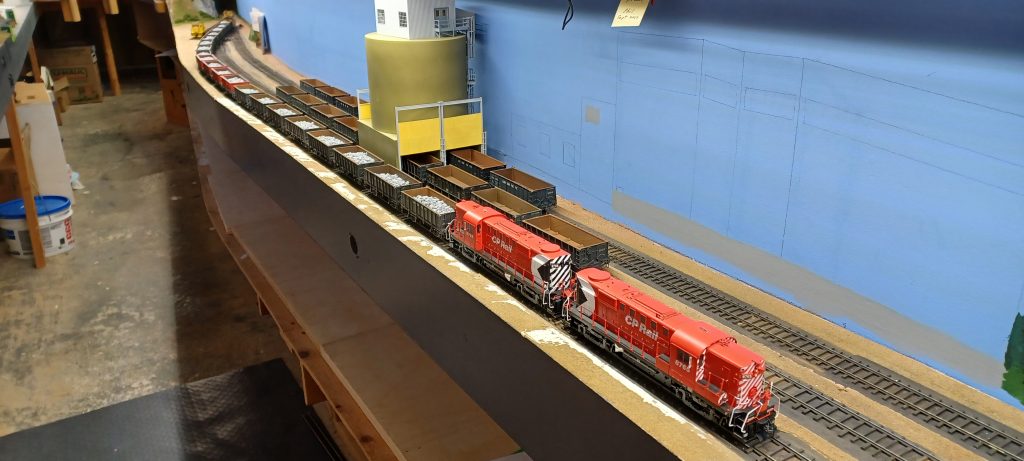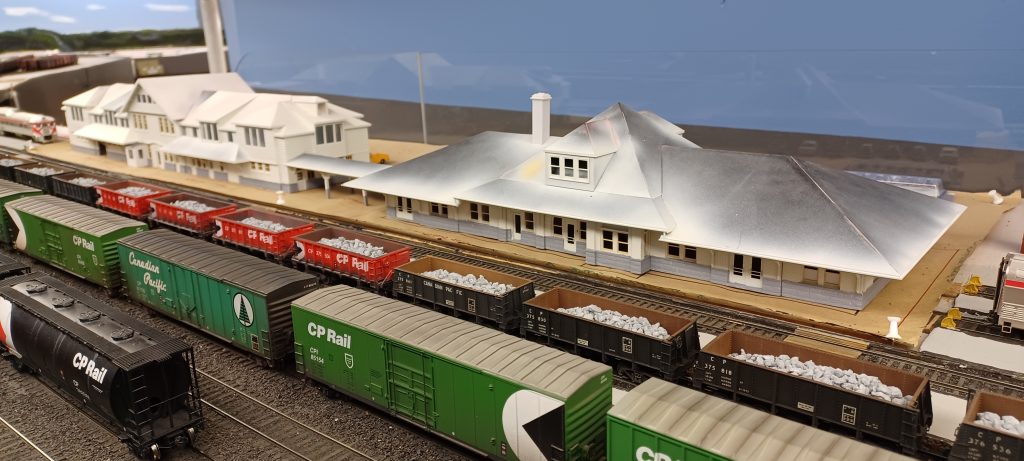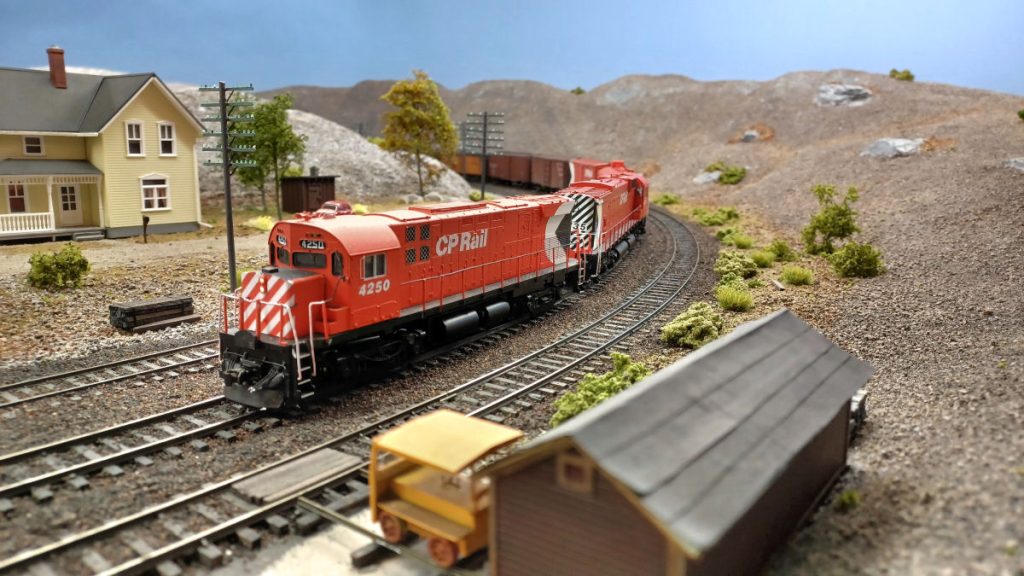It has been a while since our last blog post, so we thought a quick status update may be in order to show some of the exciting projects we’ve been working on over the winter. Also with the 2024 Doubleheaders Tour date quickly approaching, this will serve to advertise some of the new things you can expect to see if you make the trip to Maryhill.
Victoria Mine Spur (INCO – Crean Hill)
Located approximately 45km west of Sudbury, this area is situated on the southern-most end of the Sudbury Igneous Complex. The original Victoria Mine was opened in 1906 after a vein of copper-nickel ore was discovered here near the newly completed CPR line to Sault Ste Marie (the present day Webbwood Sub). A town of over 1000 residents sprang up here quickly, and thrived until the mine closed in 1930. Though Victoria Mine became a ghost town, the CPR maintained a siding here and the name lived on in employee timetables.
But as is usually the case in the Sudbury Basin, after one digging pays out another mine will usually spring up years later. And sure enough just three and a half miles away from Victoria Mine, another ore discovery was made which caused INCO to open a new mine in 1965 called Crean Hill. This caused the CPR to construct a whole new spur to service the facility, and to erect a train order station at Victoria Mine where the spur joined with the Webbwood Sub.

INCO’s Crean Hill Mine rock loader facility, as it appeared in 1991.
Our club actually built the spur down from Victoria Mine very early in layout development, as the helix that carried the Webbwood Sub between Copper Cliff and Nairn had to be built immediately, and the Victoria Mine spur ran along within the same helix. The Crean Hill mine trackage was laid early too, sometime around 2002 as best we can tell. Some rudimentary scenery sprang up, and construction of a rock loader had even begun. However the whole project sat for decades until we could re-create a large enough fleet of ore gondolas. That was the stumbling block as these ore gondolas were only used in one place on earth, Sudbury, with Canadian Pacific and INCO being the only operators. We had managed to build a small fleet of 1970-built CP cars that were produced by Sylvan Scale Models (the only correct Sudbury gondola kit ever produced) but these are craftsman resin kits that require time to build en masse. They are also long out of production.

3D printed car from series CP 375800-375999, which was a conglomeration of cars originally built between 1926 and 1942 (ex CP 376350-376849) that were rebuilt with solid floors in the mid-1970s after INCO installed a rotary dumper at Clarabelle Mill.
But time and technology march on, and present-day modellers now have the benefit of the 3D-Printer. Through the purchase of a machine and many hours of research and CAD work, our own Chris V. has been going through the whole fleet of Sudbury ore gon types, and has been very busy printing, assembling, painting and decalling the large fleet we require.

CP RS-18s 8766 and 8765 bring in the first train of empty ore gondolas to open the WRMRC’s miniature re-creation of the Crean Hill mine. The small GE 43-tonner is on loan from a member, and is substituting for INCO 65-tonner #201 that was once assigned here.
With around 50 ore gondolas now in service on the Sudbury Division, we installed all the remaining track feeders, a Tortoise switch machine on the junction switch at Victoria Mine, and cleaned all the trackage that’s been mothballed for all these years. As the photos show, the first “INCO Job-2” Crean Hill ore train has operated over the spur, exchanging 20 empties for 20 loaded gons bound for INCO’s Clarabelle mill.

The first loaded INCO-2 ore train is ready to leave Crean Hill mine. If you didn’t notice from the photos there is a real-life puzzle to switching the mine, because as the CPR Employee Timetables directly state; “Diesel units and equipment higher than ore cars must not enter rock house at Crean Hill.”
All these new 3D-printed ore gondolas, and the Crean Hill mine operation will be there for you to see if you take the 2024 Doubleheaders Tour on Saturday April the 6th. It will also gives you the chance to see how the crews running INCO-2 get around that rock house switching puzzle.
Victoria Mine Station
This project goes part and parcel with the Victoria Mine Spur entering service. With the ore trains soon becoming a reality, member Julius O. took on the task of scratch-building the diminutive Victoria Mine train order station and tool shed which stood guard over the junction switch.

Victoria Mine train order station, tool shed, and station name sign, as they appeared in 1970.
Even though the structures are small and Julius is a seasoned structure builder, there were enough outstanding questions that he required consultations with the real-life experiences of fellow WRMRC member Robin A.. As it just so happens, Robin used to be a former CPR train order agent on the Sudbury Division in the early 1970s, and had worked at Victoria Mine many a time.

Our 1:87 scale recreation of the Victoria Mine structures.
One of the more colourful anecdotes that Robin shared was of the bathroom situation at Victoria Mine, in that there was none. The station was remote and not manned 24 hours a day, so instead the CPR provided the agents with an outhouse should (more like when) the need arouse. The INCO-2 job was a night train, and so the walk to relieve yourself was dark, long, and one that could potentially cross paths with a black bear. So agents had to light a standard railway fusee to scare away any potential bruins that may have been near.

The inaugural run of the first loaded INCO-2 Crean Hill job approaching Victoria Mine.
After the tour as we turn our attention to finishing off the scenery in Victoria Mine and hide this helix for good, Robin’s story has us thinking of 3D-printing a much younger 1:87 scale version of him running from the outhouse with a lighted fusee in his hand. Apparently reddish-coloured flickering mini-LEDs exist, so this silly idea may be a thing. Stay tuned.

The INCO-2 crew stop at the Victoria Mine station to pick up orders from Agent Robin A. to return to Sudbury Yard. The infamous outhouse was moved closer to view in this photo.
Sudbury Station & Division HQ Building
The CPR station and Sudbury Division headquarters building were off-site over the past year and had a lot more work done to them. Both are now nearing completion, and are back on the layout again for the public to view on the Doubleheaders Tour.

CPR train station and Sudbury Division Headquarters buildings on the WRMRC layout.
Aside from adding the roofing shingles, the station building is pretty much completed.

Back view of the station building and division HQ.
The basic structure of the division headquarters and roof profile are now complete. The remaining windows and assorted details are still required.

Still a work in progress, but the overall division HQ structure is now completed.

The second floor on this corner of the division HQ building once housed the Sudbury Division’s dispatch offices.
Good as these photos may be, they don’t do justice to how truly impressive these structures are when you see them in person. If you can’t visit us on April 6th you’re missing out.

The combination of the station building plus nickel ore gondolas leaves no doubt as to the only place this could be; Sudbury, Ontario.
Miscellaneous Items
In addition to everything highlighted thus far there has also been a new structure completed in Sudbury, in addition to scenery expansion to Coniston (the next town east of Romford). However we’re keeping everyone online in suspense, so for now you’ll need to visit us on the tour to see what else we’ve been up to over the past while.
However one thing we’ll leave you with is something the average person will probably not see on the tour. Our signalling/electronics staff have been busy over the past months as well, and one of the more visible projects (for those of us working behind the scenes) they’ve completed is the Romford operator’s local control panel. If it looks to you like a CTC interlocking panel, that’s because the real one did too.

The local control Operator’s panel, mounted within the Parry Sound Sub staging yard / Romford Operator ‘mole’ position. It is located under the layout by the Romford junction scene.
The panel is not operational at the moment, as it and our signals are waiting on quite a bit of work before CTC can be fully implemented. But we are getting closer.
We’re looking forward to opening our doors to the public again, showing off all our latest efforts, and sharing ideas and stories with fellow modellers. That is really what our hobby is about after all. If you can’t make it, there is always our own Fall Open House to look towards, or next year’s Doubleheaders Tour. However if you plan on making it out this April the 6th, all that we’ve shown here will be there for you to see. That and around 30 other layouts to tour. Hope to see you then.


























